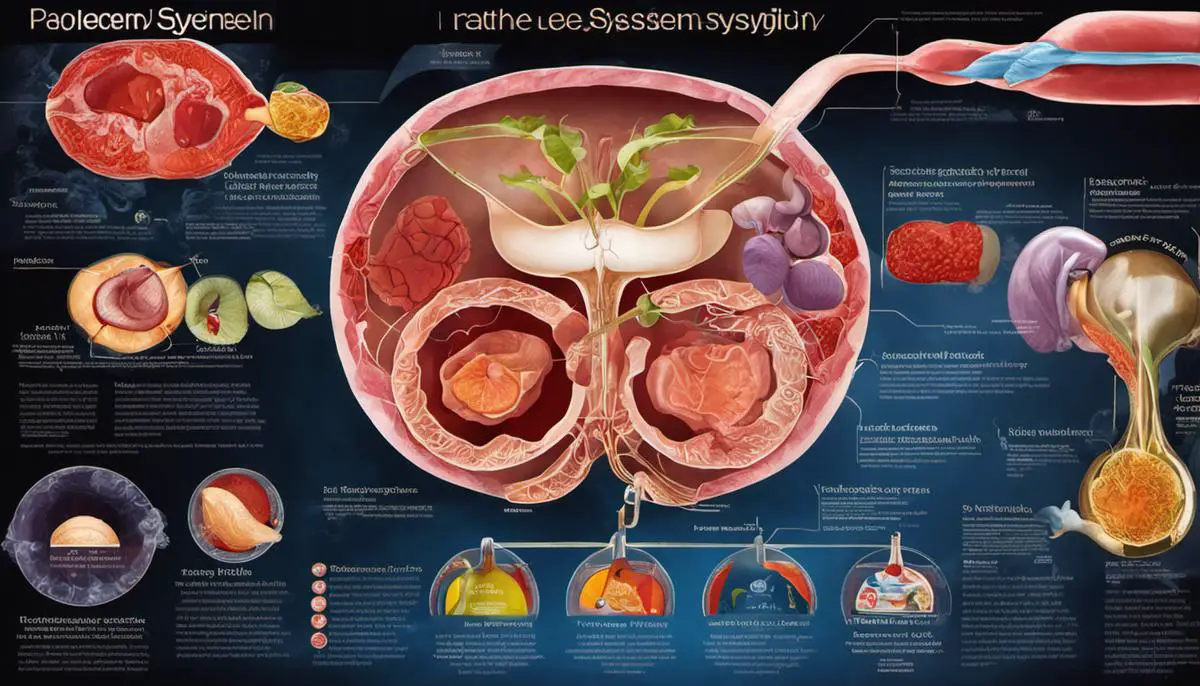The male reproductive system, a harmonious interplay between various organs, structures, and physiological processes, plays a crucial role in the human life cycle. This system’s primary function is to produce, store, and deliver sperm – the male reproductive cells needed for reproduction. It’s a fascinating combination of anatomy and function, from the intricacies of the testes, prostate gland, and seminal vesicles to the vas deferens and the penis. Essential physiological processes, such as spermatogenesis and hormonal control, govern this entire operation. But understanding this system isn’t complete without a sound knowledge of the common disorders that may affect it and the preventive measures necessary for its optimal health.
Anatomy of the Male Reproductive System
The Testes and Their Function
The testes, also known as testicles, are two glandular organs located in the scrotum (a sac of skin and muscle beneath the penis). These are the primary male reproductive organs and carry out two main functions: the production of sperm and testosterone. The process of sperm production, termed spermatogenesis, takes place in the seminiferous tubules within the testes which are responsible for creating millions of sperm cells every day. Testosterone, the primary male sex hormone, is crucial for the development of male reproductive tissues (such as testes and prostate), promoting secondary sexual characteristics (like increased muscle mass and body hair growth), and maintaining sexual drive.
The Prostate Gland and Its Role
The prostate gland is a walnut-sized structure found below the bladder and directly in front of the rectum. This gland plays two roles in reproduction: it produces a substantial portion of the fluid that makes up semen, and it assists in ejaculation. The fluid it secretes, known as prostate fluid, is milky or white in appearance and it nourishes and helps to transport sperm during ejaculation. During ejaculation, the prostate gland and pelvic muscles contract, propelling the sperm-containing semen into the urethra.
Seminal Vesicles and Their Function
Almost 70% of seminal fluid, the medium in which sperm are carried during ejaculation, is produced by the seminal vesicles. These two small, pouch-like structures are located behind the bladder and next to the prostate gland. Aside from providing a transportation method for sperm, the fluid produced by the seminal vesicles also nourishes the sperm, enhancing their ability to fertilize an egg. Additionally, this fluid contains proteins and enzymes that help semen to coagulate after ejaculation, and then later become more liquid.
The Vas Deferens Role
The vas deferens, also known as the ductus deferens, acts as a transportation route for mature sperm. This long, muscular tube extends from the epididymis, where sperm are stored and matured after production in the testes, to the urethra. During ejaculation, smooth muscles in the walls of the vas deferens contract, propelling sperm forward into the urethra.
Function of the Penis
The penis is the male organ used for sexual intercourse and urinary excretion. It is comprised of three parts: the root, the body, and the glans (the rounded top). Within the penis are a pair of cylinder-shaped vascular tissue bodies which fill with blood during sexual arousal, leading to an erection. This erection, combined with muscle contractions in the prostate gland and seminal vesicles, allow for ejaculation, the release of sperm and accompanying fluids (semen) through the urethra and out of the body. In this way, the penis is essential for the delivery of sperm for potential fertilization.
Every component of the male reproductive system has a distinct role. Together, they work to fulfill the chief responsibilities of this system; these include producing, storing, nourishing, and transporting sperm, and the production of male sex hormones. These actions enable the male to play his part in the process of conception, which is a significant facet of reproduction.

Physiological Processes
Spermatogenesis: How Sperm Production Takes Place
In the male reproductive system, sperm production is known as spermatogenesis, which primarily takes place in the testes. The process initiates with the division and multiplication of spermatogonia, the primary reproductive cells found in the seminiferous tubules within the testes. These spermatogonia then undergo sequential mitotic and meiotic divisions, culminating in four haploid spermatids from each original cell. These newly formed spermatids further mature to become spermatozoa or sperm cells, which subsequently journey to the epididymis. In the epididymis, the sperm cells are both stored and nurtured to maturity.
Hormonal Control in Male Reproductive System
Hormonal control plays a crucial role in the functioning of the male reproductive system. The hypothalamus releases gonadotropin-releasing hormone (GnRH), which stimulates the pituitary gland to release luteinizing hormone (LH) and follicle-stimulating hormone (FSH). LH triggers the testes to produce testosterone, the primary male sex hormone, which is essential for development and maintenance of secondary sexual characteristics, sperm production, and sex drive. FSH, on the other hand, is crucial for the process of spermatogenesis, aiding in the development and maturation of sperm cells.
Sexual Response
Sexual response in the male reproductive system is also a complex interaction of both psychological and physical events. This process begins with sexual arousal, which triggers the parasympathetic nervous system to increase blood flow to the penis, leading to an erection. As arousal intensifies, the sympathetic nervous system comes into play, orchestrating ejaculation. This involves contractions of muscles in the prostate gland, seminal vesicles and the base of the penis, which propel semen out of the body.
Pathway of Sperm
The journey of sperm from production to ejaculation is a multi-step process. Once developed in the seminiferous tubules, the sperm cells move into the epididymis, where they mature and gain motion. Sperm travel through the vas deferens during sexual arousal, where they mix with seminal fluid from the seminal vesicles, prostate gland, and bulbourethral glands. This fluid nourishes the sperm and provides the medium through which they travel. The mix of sperm and seminal fluid, known as semen, is then expelled from the body through the urethra during the process of ejaculation.
Understanding the Male Reproductive System
The male reproductive system consists of various interconnected components, each playing a critical part in sperm generation, maturation, and transportation. The functions of the reproductive system are interwoven in a precise manner, and any disruption in this process could impact fertility. This disruption can be caused by hormonal imbalances, physical roadblocks, diseases, or even lifestyle choices. The seamless unity of the reproductive process underscores the complexity and the sophisticated design of the male reproductive system.

Photo by bostonpubliclibrary on Unsplash
Common Disorders and Dangers
Examining Erectile Dysfunction: A Prevalent Issue in the Male Reproductive System
Erectile Dysfunction (ED) is a typical disorder that inhibits the ability of the male reproductive system to hold or maintain an erection. The primary source of ED is usually physical health conditions such as heart complexities, cholesterol issues, diabetes, obesity, or hypertension. Mental health factors like depression, anxiety, and stress can also lead to ED. This disorder is often identified by the inability to keep an erection that’s adequate for satisfactory sexual performance. Treatments usually consist of changes in lifestyle habits, mediation, psychological guidance, or possible surgical procedures. Effective preventive steps include maintaining a balanced diet, regular exercise, moderate alcohol use, and avoiding smoking.
Prostate Cancer: An Unseen Danger
Prostate cancer is a significant danger within the male reproductive system, involving the abnormal growth of cells in the prostate gland. Causes of prostate cancer are largely unknown, but risk factors include aging, family history, ethnicity, and diet. It often presents no symptoms in the early stages, but advanced stages may cause problems with urination, blood in semen, erectile dysfunction, and pain in the pelvic area. Treatment options depend on the stage of the cancer and include surgery, radiation therapy, hormone therapy, and chemotherapy. Regular screenings can help in early detection and prevention of prostate cancer.
Sexually Transmitted Infections: Silent Reproductive Disorders
Sexually transmitted infections (STIs) are infections that are passed from person to person through sexual contact. Common STIs include chlamydia, gonorrhoea, syphilis, herpes, and HIV/AIDS. The infection can cause a range of symptoms, from discomfort, ulcers, unusual discharge, to severe complications like organ damage and death in extreme cases. STIs can be prevented by using barrier methods like condoms during sexual activities, getting regular medical check-ups, and obtaining vaccinations against certain types of STIs. Early detection through testing and subsequent treatment using antibiotics or antiviral drugs is essential for controlling the spread of STIs.
Understanding Male Reproductive Dysfunction: Infertility
Infertility, often referred to as the failure to conceive after a year of unprotected intercourse, constitutes a noteworthy health concern implicating the male reproductive system. There are numerous causes including varicocele, infections, ejaculatory issues, the presence of antibodies which attack the sperm, tumors, hormonal imbalances, faults within the tubules that act as sperm carriers, and particular genetic abnormalities. Symptoms primarily present themselves in accordance with the underlying causes and may manifest through hormonal disturbances such as alterations in hair growth or sexual function. The course of treatment can span a wide spectrum, from surgical intervention to rectify physical anomalies to medications aimed at enhancing sperm production or its functional capability. Lifestyle modifications, such as smoking cessation or decreasing alcohol consumption, can also contribute positively towards fertility.

Photo by jpprommel on Unsplash
Promoting Health and Preventative Care
Steps Towards a Healthy Male Reproductive System
There are several lifestyle adjustments that can be made to promote the health and functionality of the male reproductive system. By curbing alcohol intake, abstaining from the use of illicit drugs, managing stress effectively, and refraining from tobacco use, one can enhance the overall health of the reproductive system and avert conditions like erectile dysfunction that hinder its regular performance. Regular physical activity is equally beneficial as it assists in maintaining a healthy body weight. It’s important to mention that conditions such as being overweight or obese can prompt hormonal imbalances, which in turn can adversely impact sperm production leading to infertility.
Diet for Male Reproductive Health
A balanced diet is integral to the health of the male reproductive system. Foods rich in antioxidants such as fruits, vegetables, nuts, and whole grains can help protect sperm from cellular damage. Additionally, including sources of lean protein in the diet, such as fish and poultry, can help maintain healthy levels of testosterone.
Omega-3 fatty acids, found in foods like fish and flax seeds, can also help improve blood flow, which is vital for maintaining erections. Foods rich in vitamins, especially vitamin C and E, can also contribute to sperm strength and mobility.
Regular Health Check-ups and Screenings
Regular health check-ups can help detect problems in the male reproductive system before they escalate. For instance, a prostate exam, which is typically a part of a regular health check-up for men over 40, can help detect prostate cancer early, providing a better chance for successful treatment.
Other recommended screenings for men include testicular cancer screenings, sexually transmitted infection (STI) tests, and cholesterol and blood pressure checks.
Vaccinations for Reproductive Health
Certain vaccines can also contribute to the optimal functioning of the male reproductive system. The HPV vaccine, for instance, is recommended for men up to the age of 26. Human papillomavirus (HPV) is a sexually transmitted infection that can lead to genital warts and cancers, including anal and penile cancer. The vaccine can drastically reduce these risks.
Final Thoughts on Male Reproductive Health
In conclusion, a healthy lifestyle and preventive care practices are key to optimal male reproductive health. They can help ward off potential reproductive problems. It is also beneficial to stay informed about the latest developments in health screenings and vaccines as they can provide extra protection against diseases that impair the male reproductive system.

Being informed about the male reproductive system and its functionalities not only sheds light on the science behind the miracle of reproduction but also underscores the importance of adopting a healthy lifestyle for its optimal function. Understanding the potential diseases and disorders that can impact this system gives one foresight to recognize symptoms and seek necessary treatment early. More importantly, it emphasizes the importance of preventive care and early detection through regular check-ups, screenings, and vaccinations. To ensure reproductive wellness, promoting and maintaining this system’s health must be treated as a significant part of every individual’s overall healthcare regimen.
